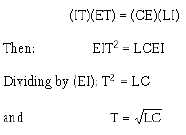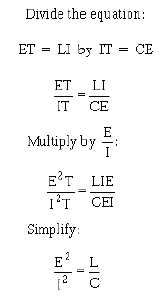3-26
This final equation is used for finding the time required for a voltage change to travel a unit length,
since L and C are given in terms of unit length. The velocity of the waves may be found by:
Where: D is the physical length of a unit
This is the rate at which the wave travels over a unit length. The units of L and C are henrys and
farads, respectively. T is in seconds per unit length and V is in unit lengths per second.
DETERMINING CHARACTERISTIC IMPEDANCE
As previously discussed, an infinite transmission line exhibits a definite input impedance. This
impedance is the CHARACTERISTIC IMPEDANCE and is independent of line length. The exact value
of this impedance is the ratio of the input voltage to the input current. If the line is infinite or is terminated
in a resistance equal to the characteristic impedance, voltage and current waves traveling the line are in
phase. To determine the characteristic impedance or voltage-to-current ratio, use the following procedure:





